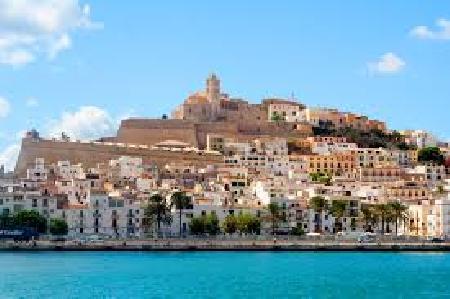 At the end of the 7th century B.C., at the beginning of the 6th century B.C., the Phoenicians left their place of residence in sa Caleta and formed Ibosim, which is now Ibiza.
At the end of the 7th century B.C., at the beginning of the 6th century B.C., the Phoenicians left their place of residence in sa Caleta and formed Ibosim, which is now Ibiza.
The place chosen by the Phoenicians to build the city was Monte Vila, from whose height the bay could be dominated. A wall was built around the city to protect it from the Greeks and the Romans. The city of Ibosim was the first city in the Balearic Islands to become the most important in the Mediterranean, thanks to the maritime trade that the Carthaginians started. The Puig des Molins necropolis, the best preserved in Phoenician culture, has remained from this era.
During the third Punic war Carthage was destroyed and in the early 2nd century B.C., the city of Ibosim became a federal city of the Roman Empire, called Ebususus. During the 5th century and after the fall of the Roman Empire, the city was captured by vandals and later by Byzantines. At the beginning of the 10th century, the city was part of the emirate of Córdoba, called Yabisa. The Muslims rebuilt the city walls, settled it and contributed to the development of the economy and culture.
In 1229 King Jaime I conquered the island of Majorca and in 1235 Ibiza, in an expedition organized by Guillem de Montgrí. The island and the city were inhabited by the Catalans. In the 16th century, even before gunfire and frequent Turkish attacks, King Felipe II ordered the construction of a new defensive wall around the city. The wall project was led by Giovanni Battista Calvi, who was later replaced by Giacomo Paleazzo. Preserved until today, the city walls have seven polygonal bastions and a ravelin. In the 18th century, during the War of Succession, by the succession of the Hispanic Confederation monarchy, in which Felipe V de Borbón and Carlos de Austria fought, Ibiza was on the side of Carlos de Austria. So the Bourbon warriors took the city and the island government lost power. The ownership of the salt mines was taken by the Crown.
The walls that surround the city of Eivissa, traditionally called Dalt Vila, have 5 entrance doors. The main door is that of ses Taules, located in front of the maritime zone of the Marina. On both sides of the door there are Roman statues, which are copies, and the originals are kept in the Archaeological Museum. Passing through this door, the Patio de Armas opens a unique place for us, with ten arches, where the island's first hippie market has been operating for many years. Passing through another door with a Roman statue, we arrive at Plaça de Vila. From this place you can choose different routes to explore this city.
During a tour of the city of Dalt Vila, it is recommended to visit places such as: Bastion and Revelin, which offer beautiful views of the bay, of the modern city of Eivissa, of Platja d'en Bossa beach, of Migjorn beach o Platja de ses Salines and the island of Formentera; the old Dominican monastery, now owned by the Eivissa city hall, where various exhibitions and dances of peasants are held; the Ibiza Cathedral (start of construction in the 14th century and end in the 18th); the Bishop's Episcopal Palace; the Archaeological Museum, located in the old university campus; the building of the former court of the Royal Curia; the Castillo del Castillo; Piazza sa Carrossa, where the statue of the popular priest and historian Isidor Macabich (Ibiza, 1883-1973) is located; the Museum of Modern Art; the Sant Ciriac Chapel, with the entrance, which according to legend was used by the Catalans to conquer the city.
The city of Dalt Vila also offers its visitors numerous bars and restaurants, shops and art galleries and small hotels.
The fortification wall that surrounds the city was declared a World Heritage Site by UNESCO in 1999. The complex also includes the Puig des Molins necropolis; the Phoenician town of sa Caleta. On this occasion, on the second weekend of May, the Eivissa city government organizes cultural and leisure holidays.
The Eivissa city government organizes regular visits with a guide to the streets of the historic Dalt Vila complex, the Marina and Sa Penya neighborhoods.
